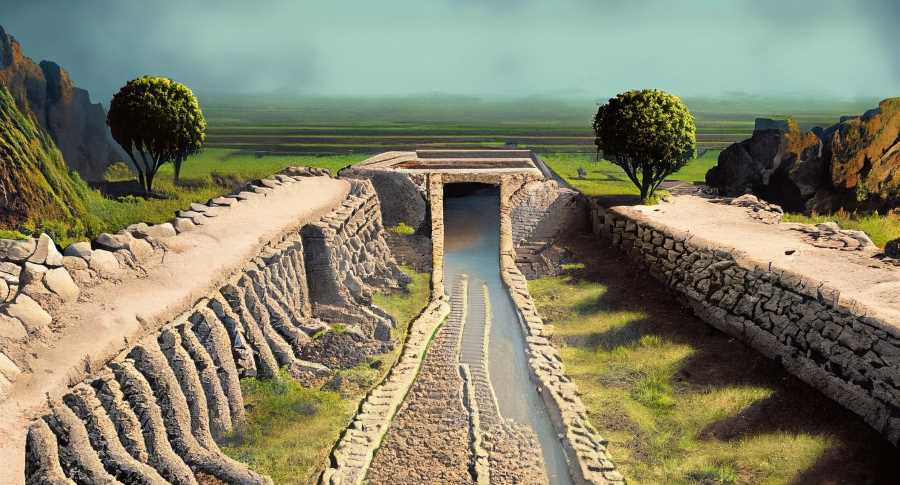How the Mexica Used 'Apantles' to Grow Bumper Crops
Uncover the ancient Mexica tradition of irrigation through the Apantles. Explore their sophisticated water management system, its impact on agriculture, and the Mexica's engineering prowess.

In the vast realm of ancient civilizations, the Mexica people left an indelible mark on the history of Central America. Among their many remarkable achievements, their sophisticated system of irrigation stands out as a testament to their engineering prowess. Today, we delve into the fascinating world of the Apantle, a crucial component of Mexica agriculture and a lifeline for their flourishing civilization.
How Apantles Work
The term "Apantle" finds its origins in the Nahuatl language, spoken by the Mexica people. It combines two words: "atl," meaning water, and "pantli," meaning row. Thus, the Apantle can be understood as a water row or a ditch specifically designed for irrigation purposes. With their advanced understanding of hydraulics, the Mexica ingeniously engineered a vast network of these ditches to ensure the prosperous growth of their crops.
Apantles work by using gravity to distribute water from a higher elevation to a lower elevation. The water is channeled into the apantle through a series of canals, and it flows down the apantle to the fields below. The water is then distributed to the crops through a system of ditches and furrows. Apantles can be used to irrigate a variety of crops, including corn, beans, and squash. They are also used to irrigate orchards and vineyards. Apantles are versatile irrigation systems that can be adapted to a variety of agricultural needs.
There are many benefits to using apantles for irrigation. Apantles are a sustainable and efficient way to irrigate crops. They help to conserve water resources, and they are less expensive to maintain than other irrigation systems, such as sprinkler systems. Apantles also help to improve the quality of the water that is used to irrigate crops. As the water flows through the apantle, it is filtered by the rocks and soil, which removes impurities and pollutants. This results in cleaner, healthier water for the crops.
There are a few challenges associated with using apantles for irrigation. One challenge is that apantles can be susceptible to damage from flooding and erosion. Another challenge is that apantles can be difficult to clean, which can lead to the accumulation of sediment and debris. Despite these challenges, apantles are a valuable irrigation system that has been used for centuries in Mexico. Apantles are a sustainable and efficient way to irrigate crops, and they help to conserve water resources.
Apantles in Mexica Agriculture
Agriculture was the backbone of the Mexica civilization, providing sustenance for their rapidly expanding population. The Apantles played a crucial role in ensuring the success of their agricultural endeavors. By effectively managing water distribution, the Mexica could cultivate crops throughout the year, maximizing their harvests and minimizing the risk of drought-induced crop failures.
The Apantle system was a marvel of engineering, featuring an intricate network of canals and ditches. These channels crisscrossed the Mexica landscape, carrying water from nearby rivers and lakes to the farmlands. The Mexica employed a sophisticated series of gates and locks to control the water flow, allowing them to regulate irrigation according to the needs of each field.
The advent of the Apantle system revolutionized Mexica society in numerous ways. First and foremost, it enabled them to support a rapidly growing population, fostering urbanization and the development of magnificent cities like Tenochtitlan, which was built on an island in the middle of Lake Texcoco. The abundance of crops cultivated through the Apantles also fueled trade and economic prosperity, strengthening the Mexica empire's influence and wealth.

The Mexica Approach to Irrigation
The Mexica people maintained a deep reverence for nature and sought to establish a harmonious relationship with their surroundings. Unlike some civilizations that relied solely on natural rainfall for agriculture, the Mexica recognized the importance of proactive water management. By carefully constructing and maintaining the Apantles, they demonstrated their commitment to sustainable and efficient use of water resources.
While the Mexica civilization eventually succumbed to the Spanish conquest, the legacy of the Apantles lives on. Today, scholars and historians work tirelessly to unravel the secrets of this remarkable irrigation system. By studying ancient texts, archaeological remains, and indigenous knowledge, they continue to piece together the intricate details of the Apantles, shedding light on Mexica agricultural practices and the mastery of their hydraulic engineering.
Appreciating the Mexica Ingeniousness
The Apantles serve as a testament to the Mexica people's ingenuity and adaptability. Their ability to create an extensive irrigation system using the resources available to them showcases their advanced understanding of hydraulic engineering. The Apantles was not only a practical solution to ensure agricultural productivity but also a symbol of the Mexica's profound connection with the natural world.
In conclusion, the Apantles stands as a remarkable testament to the Mexica people's advanced agricultural practices and engineering skills. The intricate network of ditches and canals allowed for efficient water management, enabling the Mexica civilization to flourish and sustain its population. The Apantles played a pivotal role in Mexica agriculture, ensuring year-round crop cultivation and minimizing the risk of food shortages.




